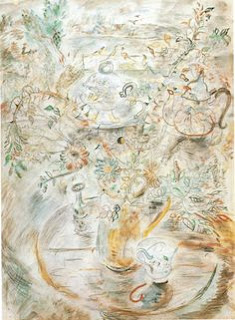Drawings of flowers have a deep connection to what are usually called 'vanitas' or 'memento mori' images. These images were designed to remind the viewer of their own mortality and of the worthlessness of worldly goods and pleasures. However it is not only the subject matter that can operate in this way, the actual approach to making an image can open out a meditation on the fragile relationship between the physicality of the world and the fleeting moment of its perception.
Leonard McComb
There is a particular approach to drawing that I always warm to, it's what I would call an 'uncertain certainty'. Some of the artists that I go back and look at over and over again have this quality, which is about time and touch, as well as about the interrelationship between mass and space, or if you want to get more religious about it, the spirit and the body.
The best of Leonard McComb's drawings have it. An almost spiritual radiance emanates from his drawings of flowers. It's as if he is trying to touch the petals with his eyes, each mark a caress of direction and an attempt to feel around the mass. He builds these drawings up with small directional marks, marks that at their inception appear to be looking for the form, but as they build up, they energise the space, eventually space and mass interpenetrate, all now vibration.
This drawing of a fish seems to capture both its material condition and the moment that it's iridescence makes it become as transient as a soap bubble. It is indeed a 'memento mori'.
Leonard McComb
The historical precedence for these drawings is once again Cezanne, in particular the late watercolours.
Cezanne
David Jones is another artist that developed a body of work using a similar tentative and yet sure touch that feels as if he is delicately searching for the rhythms that lie underneath what we see.
David Jones
It's interesting to compare artists working in this way to someone using a similar subject matter, Graham Crowley's flowers are a composition of solids, specks of white oil paint dot over the charcoal drawing, giving a superficial appearance of spatial opening, but when you look beneath the surface, each flowerhead is in fact seen as a mass, it's just that there are so many of them that their sheer number activate the surface and create a spatial rhythm. Mass in action, rather than mass turning into energy. A sort of dark flower power.
Graham Crowley
If you look at Claude Heath's drawings of a head by touch, there is also an uncertain certainty, which also relates to the idea of vision as a sort of feeling or touch.
Claude Heath
Michelangelo had a wonderful sense of touch, and was also a master of that uncertain certainty. The difference is that this is not a drawing done from observation, it is done by someone searching for an image. The search itself is attempting to carve the image out of the paper, each mark chisel like, the body gradually dissolving into energy, the mass becoming spirit.
Michelangelo
Adriaen van Ultrecht
The painting above by Adriaen van Ultrecht, exemplifies many of the traditional conventions of 'vanitas' painting. The skull, the flowers, a closed book etc., this still-life (in French: nature morte) is designed in such a way that our gaze is focused on the moment of frozen perception, the glint of light on a glass, the texture of a fallen petal, or the crumple of paper. The artist holds us in the moment, but the surfaces of these objects are what they are about. The interaction of looking, the oscillation of the eyes is not recorded, life is not captured, only the objects' surface appearance. I could argue that the painting is 'without life', hermetically sealed and 'finished'. Whilst the more uncertain images further above are open to life, forever emerging into being, and as such a much deeper metaphor and one that goes beyond a Capitalist fascination with objects and things. When Adriaen van Ultrecht painted his image, the Low Countries were central to the development of world trade as we now know it, and we often see images of things constructed during this time as measures against which metaphors for the condition of our lives could be constructed. People become measured by their possessions. A condition that still in many ways persists, one which I would argue against and suggest that we need to be more aware of the flux and flow of interrelationships between the world and ourselves, and consider how what we do impacts upon the world; which is why I am drawn so strongly to that uncertain certainty; something you can never own, only meditate upon.
Brass shell-case, with flowers
In my own work I have occasionally needed to reflect on things in such a way that I need use a visual language that supports the struggle to 'see' an idea. In the case of the drawing above, it is of a shell case that my grandfather brought back from the First World War, it is now used as a flower vase. As in Adriaen van Ultrecht's painting flowers are used as a symbol of mortality, their conjunction with the shell-case suggesting the explosive release of the shell from the gun barrel as well as those moments in history when flowers have been used to spike the guns. It is though in the tentative marks used that the real story lies.
See also:
The uncertainty principle is also an issue that raises its head when thinking about quantum mechanics see these posts:















Wow... Fish art is simply superb...
ReplyDelete